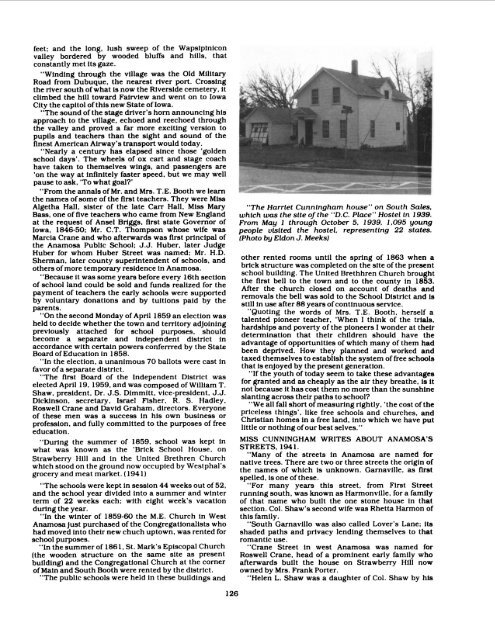Anamosa - A Reminiscence 1838 - 1988
The definitive history of the community of Anamosa, Iowa, USA
The definitive history of the community of Anamosa, Iowa, USA
You also want an ePaper? Increase the reach of your titles
YUMPU automatically turns print PDFs into web optimized ePapers that Google loves.
feet; and the long, lush sweep of the Wapsipinicon<br />
valley bordered by wooded bluffs and hills, that<br />
constantly met its gaze.<br />
“Winding through the village was the Old Military<br />
Road from Dubuque, the nearest river port. Crossing<br />
the river south of what is now the Riverside cemetery. it<br />
climbed the hill toward Fairview and went on to Iowa<br />
City the capitol of this new State of Iowa.<br />
“The sound of the stage driver's hom announcing his<br />
approach to the village, echoed and reechoed through<br />
the valley and proved a far more exciting version to<br />
pupils and teachers than the sight and sound of the<br />
finest American Airway's transport would today.<br />
“Nearly a century has elapsed since those ‘golden<br />
school days‘. The wheels of ox cart and stage coach<br />
have taken to themselves wings, and passengers are<br />
‘on the way at infinitely faster speed, but we may well<br />
pause to ask. ‘To what goal?’<br />
“From the annals of Mr. and Mrs. T.E. Booth we ieam<br />
the names of some of the first teachers. They were Miss<br />
Algetha Hall, sister of the late Can‘ Hall, Miss Mary<br />
Bass, one of flve teachers who came from New England<br />
at the request of Ansel Briggs. first state Governor of<br />
Iowa, 1846-50; Mr. C.T. Thompson whose wife was<br />
Marcia Crane and who afterwards was first principal of<br />
the <strong>Anamosa</strong> Public School; J.J. Huber, later Judge<br />
Huber for whom Huber Street was named: Mr. H.D.<br />
Sherman. later county superintendent of schools, and<br />
others of more temporary residence in <strong>Anamosa</strong>.<br />
“Because it was some years before every 16th section<br />
of school land could be sold and funds realized for the<br />
payment of teachers the early schools were supported<br />
by voluntary donations and by tuitions paid by the<br />
parents.<br />
"On the second Monday of April 1859 an election was<br />
held to decide whether the town and territory adjoining<br />
previously attached for school purposes, should<br />
become a separate and independent district in<br />
accordance with certain powers conferrred by the State<br />
Board of Education in 1858.<br />
“In the election, a unanimous 70 ballots were cast in<br />
favor of a separate district.<br />
“The first Board of the Independent District was<br />
elected April 19. 1959, and was composed of William T.<br />
Shaw. president. Dr. J .S. Dimmitt. vice-president, J .J .<br />
Dickinson, secretary. Israel Fisher, R. S. Hadley,<br />
Roswell Crane and David Graham, directors. Everyone<br />
of these men was a success in his own business or<br />
profession, and fully committed to the purposes of free<br />
education.<br />
“During the summer of 1859. school was kept in<br />
what was known as the ‘Brick School House, on<br />
Strawberry Hill and in the United Brethren Church<br />
which stood on the ground now occupied by Westphal's<br />
grocery and meat market. (1941)<br />
"The schools were kept in session 44 weeks out of 52,<br />
and the school year divided into a summer and winter<br />
term of 22 weeks each; with eight week's vacation<br />
during the year.<br />
"In the winter of 1859-60 the M.E. Church in West<br />
<strong>Anamosa</strong> just purchased of the Congregationalists who<br />
had moved into their new chuch uptown. was rented for<br />
school purposes.<br />
"In the summer of 1861, St. Mark's Episcopal Church<br />
(the wooden structure on the same site as present<br />
building) and the Congregational Church at the corner<br />
of Main and South Booth were rented by the district.<br />
“The public schools were held in these buildings and<br />
~P.:-irn-“--"~‘!';'!"_"<br />
‘-<br />
“The Harriet Cunningham house" on South Sales.<br />
which was the site of the "D.C. Place" Hostel in I939.<br />
From May 1 through October 5. 1939. I .095 young<br />
people visited the hostel, representing 22 states.<br />
(Photo by Eldon J. Meeks)<br />
other rented rooms until the spring of 1863 when a<br />
brick structure was completed on the site of the present<br />
school building. The United Brethhren Church brought<br />
the first bell to the town and to the county in 1853.<br />
After the church closed on account of deaths and<br />
removals the bell was sold to the School District andi<br />
still in use after 88 years of continuous service.<br />
“Quoting the words of Mrs. T.E. Booth. herself a<br />
talented pioneer teacher. ‘When I think of the trials.<br />
hardships and poverty of the pioneers I wonder at their<br />
determination that their children should have the<br />
advantage of opportunities of which many of them had<br />
been deprived. How they planned and worked and<br />
taxed themselves to establish the system of free schools<br />
that is enjoyed by the present generation.<br />
“If the youth of today seem to take these advantages<br />
for granted and as cheaply as the air they breathe, is it<br />
not because it has cost them no more than the sunshine<br />
slanting across their paths to school?<br />
“We all fall short of measuring rightly. ‘the cost of the<br />
priceless things‘, like free schools and churches, and<br />
Christian homes in a free land, into which we have put<br />
little or nothing ofour best selves.“<br />
MISS CUNNINGHAM WRITES ABOUT ANAMOSA‘S<br />
STREETS, 1941.<br />
“Many of the streets in <strong>Anamosa</strong> are named for<br />
native trees. There are two or three streets the origin of<br />
the names of which is unknown. Garnaville. as first<br />
spelled. is one of these.<br />
“For many years this street, from First Street<br />
running south, was known as Harmonville, for a family<br />
of that name who built the one stone house in that<br />
section. Col. Shaw's second wife was Rhetta Harmon of<br />
this family.<br />
“South Garnaviilo was also called Lover's Lane; its<br />
shaded paths and privacy lending themselves to that<br />
romantic use.<br />
“Crane Street in west <strong>Anamosa</strong> was named for<br />
Roswell Crane, head of a prominent early family who<br />
afterwards built the house on Strawberry Hill now<br />
owned by Mrs. Frank Porter.<br />
"Helen L. Shaw was a daughter of Col. Shaw by his<br />
I 26



